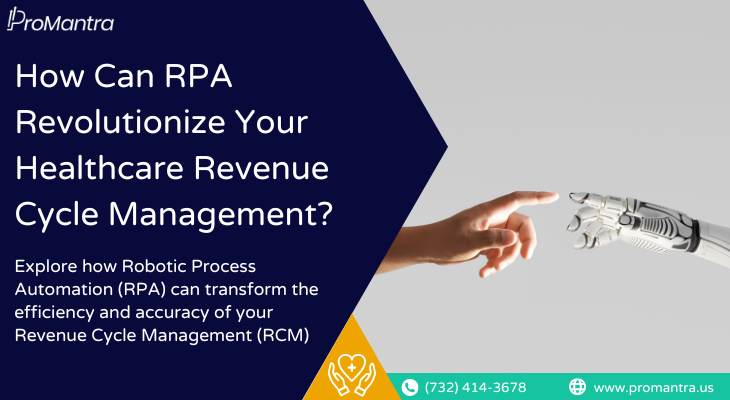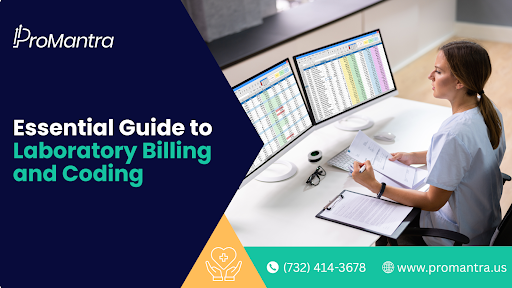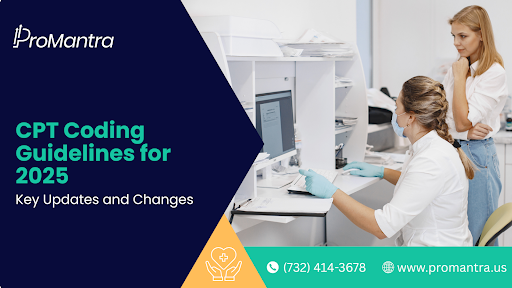For healthcare providers in today’s demanding landscape, managing the revenue cycle is an ever-present challenge. Reimbursement rates are declining, administrative costs are rising, and the pressure to collect payments efficiently is immense. This complex process, encompassing everything from patient registration to claim submission and payment collection, can become a bottleneck, hindering financial stability and impacting patient care delivery.
Robotic Process Automation (RPA) is emerging as a game-changer in healthcare RCM. RPA in revenue cycle management utilizes software “bots” that mimic human actions within computer systems. These bots can automate repetitive, rule-based tasks, freeing up valuable human resources and streamlining workflows. Imagine a tireless, error-free assistant handling data entry, claim submissions, and even following up on denials – that’s the power of RPA in action.
Optimizing RCM for a Healthy Bottom Line
Optimizing your RCM is no longer a luxury, it’s a necessity. By minimizing errors, improving efficiency, and accelerating cash flow, RPA empowers healthcare organizations to:
- Reduce administrative costs: Freeing up staff from repetitive tasks allows them to focus on higher-value activities, leading to improved cost-effectiveness.
- Enhance revenue capture: Faster and more accurate claim processing translates to fewer denials and quicker reimbursements.
- Improve patient satisfaction: By streamlining processes, RPA can contribute to a smoother patient experience, with faster turnaround times and fewer billing errors.
What is Robotic Process Automation (RPA)?
Imagine a tireless, digital assistant that can automate repetitive tasks on your computer with incredible accuracy. That’s the essence of Robotic Process Automation in healthcare. RPA in revenue cycle management utilizes software bots that can mimic human actions within digital systems. These bots can follow specific instructions, navigate different applications, and manipulate data – essentially replicating the way humans perform routine tasks.
RPA’s Reach Across Industries
RPA has gained significant traction across various industries, streamlining operations in sectors like finance, banking, and manufacturing. In repetitive, data-driven environments, RPA shines. For example, bots can automate tasks like data entry, generating reports, and processing invoices, freeing up human employees for more complex, analytical work.
Revolutionizing Healthcare RCM
The healthcare industry, particularly the realm of Revenue Cycle Management automation, is a prime example where RPA delivers exceptional value. RCM involves a multitude of tedious, rule-based tasks, perfectly suited for RPA in revenue cycle management automation revenue cycle. Here’s where RPA shines in healthcare:
- Minimizing Errors: Data entry mistakes can lead to claim denials and delays. RPA bots, on the other hand, handle data flawlessly, ensuring accuracy in every step of the RCM process.
- Boosting Efficiency: RPA automates time-consuming tasks like claim submission and following up on denials, freeing up staff to focus on higher-value activities like patient interaction.
- Enhancing Patient Experience: Faster claim processing and reduced administrative burdens contribute to a smoother patient experience.
The Power of RPA in Healthcare RCM
The burden of manual tasks in healthcare Revenue Cycle Management weighs heavily on staff and hinders financial performance. Here’s where Robotic Process Automation in healthcare emerges as a game-changer. By automating repetitive, rule-based tasks, RPA unlocks a treasure trove of benefits, transforming your RCM into a well-oiled machine. Let’s delve deeper into how RPA boosts efficiency, reduces costs, minimizes errors, and ultimately enhances the patient experience.

Efficiency Gains: Reclaim Your Time and Resources
Imagine a tireless assistant handling the mundane yet critical tasks that consume valuable staff time in RCM. RPA offers precisely that:
- Claims Processing: Consider the tedious process of gathering patient information, verifying insurance coverage, scrubbing claims for errors, and finally submitting them electronically. RPA bots can automate these entire steps, freeing up your staff to tackle complex cases and dedicating their expertise to areas like denial management and patient communication. This translates to a significant reduction in turnaround times – claims are submitted faster, leading to quicker reimbursements and improved cash flow.
- Payment Posting: Manually matching payments to patients and updating accounts receivable can be a time-consuming and error-prone process. RPA automates this task, ensuring accuracy and freeing up staff to focus on more strategic financial activities. Additionally, automated payment posting provides real-time visibility into cash flow, allowing for better financial planning and resource allocation.
The impact is clear: reduced turnaround times across all key RCM functions. This translates to improved productivity, as staff are empowered to dedicate their time to higher-value activities directly impacting patient care. Studies by the American Hospital Association (AHA) indicate that RPA can automate up to 80% of repetitive RCM tasks, leading to a 20-30% increase in staff productivity.
Cost Reduction: A Healthy Bottom Line for Your Organization
In today’s competitive healthcare landscape, cost optimization is paramount. RPA offers a strategic advantage by minimizing administrative costs and improving revenue collection:
- Minimizing Administrative Costs: Repetitive tasks like data entry, claim scrubbing, and payment posting typically require dedicated staff resources. By automating these tasks with RPA, you can significantly reduce the need for additional personnel. This translates to substantial cost savings in the long run, freeing up financial resources that can be directed towards patient care initiatives or technology upgrades.
- Improving Revenue Collection: Errors in claims submission and delayed claim processing are costly for healthcare providers. RPA ensures accuracy in data entry and adherence to payer rules, minimizing denials and rework. Additionally, faster claim processing leads to quicker reimbursements, improving cash flow and overall financial health. A study found that healthcare organizations can achieve a 10-15% reduction in claim denials through RPA implementation.
Error Reduction and Compliance: Peace of Mind Through Automation
Accuracy is the cornerstone of effective RCM. Even minor errors in data entry or claim submission can result in denials, delays, and financial penalties. Here’s where RPA excels:
- Enhancing Accuracy: RPA eliminates the human error factor from data entry and claims management. Bots tirelessly follow programmed instructions, ensuring consistency and accuracy throughout the RCM process. This minimizes the risk of denials and rework, leading to smoother operations and improved financial performance.
- Ensuring Compliance: Navigating the complex web of healthcare regulations and payer requirements can be a challenge. RPA eliminates the risk of non-compliance by ensuring adherence to specific rules and protocols. Bots can be programmed to automatically update patient information based on eligibility changes, verify insurance coverage against payer rules, and flag potential compliance issues. This proactive approach mitigates the risk of audits and penalties, giving you peace of mind.
Enhanced Patient Experience: A Positive Impact on All Stakeholders
A smooth and efficient patient experience is crucial for any healthcare organization. RPA plays a vital role by:
- Faster Billing Processes: Streamlined claim processing leads to quicker patient invoicing and avoids unnecessary delays in payments. This reduces patient frustration and improves the overall billing experience.
- Improved Transparency: RPA can be integrated with patient portals, allowing for real-time access to billing information and clear communication regarding charges and insurance coverage. This transparency builds trust and fosters a positive relationship between patients and the healthcare provider.
RPA empowers healthcare organizations to not only optimize RCM for efficiency and cost-effectiveness but also contributes to a more positive patient experience. By automating time-consuming tasks, ensuring accuracy, and enhancing compliance, RPA allows healthcare providers to focus on what matters most – delivering high-quality patient care. In the next section, we’ll explore specific use cases where RPA can be implemented within your RCM, showcasing its transformative potential in action.
Key Use Cases of RPA in Healthcare RCM
We’ve established the significant benefits RPA offers in healthcare RCM. Now, let’s delve into specific use cases where RPA can be implemented, showcasing its real-world impact:
1. Medical Billing Automation: Reclaim Time and Reduce Errors
- Streamlining Payment Posting and Claims Administration: Imagine a world where RPA automatically matches patient payments, updates accounts receivables, and generates accurate invoices. This is precisely what RPA can do. By automating these tasks, staff are freed from tedious data entry, allowing them to focus on resolving complex billing issues and improving patient communication.
- Case Study: Efficiency Boost for a Hospital Network: A large hospital network implemented RPA to automate payment posting. The results were impressive: a 40% reduction in manual work for staff and a 25% improvement in claim submission accuracy. This translated to faster cash flow and fewer denials.
2. Claims Processing and Adjudication: Eliminate Errors and Expedite Reimbursements
- Automating Data Entry and Validation: RPA bots can seamlessly extract patient information from various sources, populate claim forms accurately, and automatically validate data against payer rules. This minimizes errors and ensures claims are submitted correctly the first time, reducing the risk of denials and rework.
- Handling Complex Denial Management Processes: Denial management is a time-consuming and often frustrating process. RPA can automate tasks like gathering missing information, submitting appeals, and following up with payers. This streamlines the process, improves denial resolution rates, and accelerates reimbursements.
3. Patient Eligibility Verification: Ensure Smooth Scheduling and Accurate Billing
- Automating Eligibility Checks: RPA can automate the process of verifying patient eligibility with insurance companies. This reduces the administrative burden on staff and ensures appointments are scheduled only for eligible patients, minimizing the risk of denied claims due to coverage issues.
- Reducing Errors in Insurance Verification Processes: Manual verification of insurance information is prone to errors. RPA eliminates this risk by automatically verifying patient coverage details, leading to accurate billing and improved patient satisfaction.
4. Prior Authorizations: Expedite Treatment and Reduce Delays
- Automating Prior Authorization Requests and Status Checks: Prior authorizations are a common hurdle in healthcare. RPA can automate the process of submitting requests and checking their status with payers. This frees up staff time and reduces delays in obtaining approvals, ensuring patients receive timely treatment.
- Improving Workflow Efficiency and Reducing Delays: A study Intelligence estimates that RPA can reduce prior authorization processing times by up to 70%. This translates to improved patient care coordination and faster access to necessary treatments.
These are just a few examples of how RPA can be implemented in RCM. By automating these key tasks, healthcare organizations can achieve significant improvements in efficiency, accuracy, and overall financial performance. In the next section, we’ll explore the challenges of implementing RPA and how to overcome them to unlock its full potential.
Implementing RPA in Healthcare RCM
While RPA offers a compelling solution for optimizing RCM, it’s important to acknowledge there are challenges to consider. However, with careful planning and the right approach, these hurdles can be overcome:
Integration with Existing IT Systems:
- Electronic Health Records (EHR) and Practice Management Software: A critical consideration is ensuring seamless integration of RPA bots with your existing healthcare IT infrastructure, such as Electronic Health Records (EHR) and practice management software. This might require collaboration with your IT team and potential customization of the RPA solution.
Selecting the Right RPA Tools and Vendors:
- Matching Your Needs: With a growing number of RPA vendors in the market, selecting the right solution is crucial. Carefully evaluate the features and functionalities offered by different vendors, ensuring they align with your specific RCM needs and automation goals.
Here are some additional tips for a successful RPA implementation:
- Start Small and Scale Up: Begin by automating a few well-defined tasks within RCM. This allows you to demonstrate the value of RPA and gain experience before scaling up to automate more complex processes.
- Change Management and User Adoption: Implementing RPA represents a change in workflow for your staff. A well-defined change management strategy is essential, addressing staff concerns and providing comprehensive training to ensure user adoption and maximize the benefits of RPA.
- Data Security and Compliance: Healthcare data is highly sensitive. Ensure the RPA solution you choose adheres to strict security protocols and regulatory compliance standards (HIPAA) to safeguard patient information.
By carefully considering these challenges and following a strategic implementation plan, healthcare organizations can unlock the full potential of RPA and transform their RCM for improved efficiency, cost savings, and ultimately, better patient care.
Best Practices for RPA Adoption in RCM
We’ve explored the transformative potential of RPA in healthcare RCM. Now, let’s delve into best practices to ensure a smooth and successful implementation:

1. Developing a Strategic Roadmap:
Don’t jump straight into automation! A well-defined strategy is the cornerstone of successful RPA adoption:
- Identify Automation Opportunities: Carefully analyze your RCM processes and pinpoint tasks that are repetitive, rule-based, and high-volume. These are prime candidates for RPA automation.
- Prioritize Based on Impact: Evaluate the potential impact of automating each task. Consider factors like time saved, cost reduction, and potential improvement in accuracy. Prioritize tasks with the highest impact to maximize the return on investment (ROI) from RPA.
- Develop a Phased Implementation Plan: Start by automating a few key tasks within RCM. This allows you to demonstrate the value of RPA, gain experience with the technology, and identify any unforeseen challenges before scaling up to automate more complex processes.
2. Training Staff and Managing Change Effectively:
Implementing RPA represents a shift in workflow for your staff. Effective change management is crucial to ensure user adoption and maximize the benefits:
- Open Communication and Transparency: Communicate the benefits of RPA to your staff, addressing any concerns they might have about job displacement. Emphasize how RPA will free them from tedious tasks, allowing them to focus on higher-value activities.
- Comprehensive Training: Provide your staff with in-depth training on how to interact with the RPA solution. This can include training on identifying automation opportunities, working alongside RPA bots, and troubleshooting any issues that might arise.
- Change Management Strategy: Develop a comprehensive change management strategy that includes ongoing communication, training resources, and support mechanisms to address staff concerns and ensure a smooth transition to the new workflow.
Additional Best Practices
- Data Quality is Key: The success of RPA hinges on accurate data. Ensure your data is clean and standardized before implementing automation to avoid errors and inefficiencies.
- Security and Compliance: Prioritize data security by choosing an RPA solution that adheres to HIPAA regulations and safeguards sensitive patient information.
- Performance Monitoring and ROI Measurement: Continuously monitor the performance of your RPA solution and track the return on investment (ROI). This allows you to identify areas for improvement and optimize your RPA strategy for long-term success.
By following these best practices and carefully considering the implementation challenges, healthcare organizations can embark on a successful RPA journey, transforming their RCM into a well-oiled machine that drives efficiency, cost-effectiveness, and ultimately, a more positive patient experience.
Future Trends and Innovations in RPA
The world of RPA is constantly evolving, and the future holds exciting possibilities for its application in healthcare RCM. Let’s explore some emerging trends that will shape the future of RPA:
- Integration with Artificial Intelligence (AI): The marriage of RPA and AI will unlock even greater potential. AI-powered bots can learn and adapt over time, automate tasks requiring more complex decision-making, and further enhance the accuracy and efficiency of RCM processes.
- Cognitive Automation: This next-generation of automation goes beyond simple rule-based tasks. Cognitive automation tools can understand and interpret natural language, analyze unstructured data like clinical notes, and even mimic human judgment in certain scenarios. This will allow RPA to tackle more complex aspects of RCM, such as automating prior authorization requests with justifications based on patient medical records.
- Cloud-Based RPA Solutions: Cloud-based deployment offers several advantages, including scalability, affordability, and easier access to the latest RPA features. This makes RPA more accessible to healthcare organizations of all sizes, further accelerating its adoption in RCM.
Predictions for RPA’s Evolution in RCM:
- End-to-End Automation: RPA will progress beyond automating isolated tasks, moving towards end-to-end automation of entire RCM workflows. This will streamline processes significantly, minimizing human intervention and reducing errors.
- Enhanced Patient Engagement: RPA can be integrated with patient portals, allowing for real-time access to billing information and facilitating self-service options for payments and appointment scheduling. This will empower patients and improve their overall healthcare experience.
- Improved Regulatory Compliance: RPA can be programmed to automatically monitor and ensure adherence to evolving healthcare regulations. This will minimize the risk of audits and penalties, allowing healthcare providers to focus on delivering quality care.
RPA is not a passing fad; it’s a transformative technology poised to revolutionize healthcare RCM. By embracing RPA and staying abreast of emerging trends, healthcare organizations can unlock a future of optimized workflows, improved financial performance, and a more patient-centric healthcare experience.
Robotic Process Automation (RPA) has emerged as a game-changer, and ProMantra is at the forefront of implementing this technology to optimize your revenue cycle.
We’ve explored the compelling benefits of RPA in RCM: from boosting efficiency and minimizing errors to streamlining workflows and reducing costs. ProMantra’s RPA solutions are designed specifically for the healthcare industry, ensuring seamless integration with your existing IT infrastructure and addressing the unique challenges of RCM.
Here’s why ProMantra is your ideal partner for RPA optimization:
- Deep Healthcare Expertise: Our team understands the intricacies of healthcare RCM and can tailor RPA solutions to address your specific needs and challenges.
- Proven Track Record: ProMantra has a successful history of helping healthcare organizations leverage RPA to achieve significant improvements in efficiency, cost-savings, and overall financial performance.
- Scalable and Secure Solutions: Our RPA solutions are designed to grow alongside your organization, ensuring scalability and adaptability. We prioritize data security and compliance with HIPAA regulations to safeguard sensitive patient information.
Don’t let the burden of RCM hinder your organization’s success. By partnering with ProMantra and embracing RPA, you can unlock a future of streamlined workflows, enhanced patient experiences, and a healthier bottom line.
Contact ProMantra today to schedule a consultation and explore how our RPA solutions can transform your RCM. Let’s work together to optimize your revenue cycle and empower your healthcare organization to deliver exceptional care.




